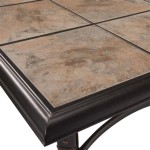Frank Lloyd Wright Patio Furniture: Bringing Architectural Vision Outdoors
Frank Lloyd Wright, widely considered one of the most influential architects of the 20th century, revolutionized architectural design with his organic philosophy. This philosophy extended beyond buildings into the very furnishings that populated those spaces. While perhaps best known for his iconic structures like Fallingwater and the Guggenheim Museum, Wright also conceived of furniture designs, including pieces intended for outdoor use. This article explores the world of Frank Lloyd Wright patio furniture, examining its key characteristics, its historical context, and its continuing appeal.
Understanding Frank Lloyd Wright's approach to design is crucial to appreciating his patio furniture. He believed in creating a unified aesthetic, where the building, its interior, and its surrounding landscape were all interconnected and harmoniously integrated. This concept, often referred to as "organic architecture," permeated all aspects of his work. Wright sought to blur the boundaries between the indoors and outdoors, using expansive windows, terraces, and carefully planned landscaping to connect residents with nature. Patio furniture, therefore, became an essential element in realizing this vision.
The Hallmarks of Frank Lloyd Wright Patio Furniture Design
Frank Lloyd Wright's patio furniture, consistent with his overall design principles, displays several distinct characteristics. Key among these are geometric simplicity, the use of natural materials, and a strong emphasis on functionality. These elements weren't simply aesthetic choices; they were integral to Wright's belief that design should serve a purpose and enhance the user's experience.
Geometric simplicity is a defining feature. Wright frequently employed clean lines, rectangular forms, and subtle angles in his furniture designs. Ornamentation was minimized, replaced by the inherent beauty of the materials themselves. This minimalist approach ensured that the furniture didn't compete with its surroundings but rather complemented the architectural space and the natural landscape.
The use of natural materials was paramount. Wright favored materials such as wood, stone, and metal, selected for their durability, their aesthetic qualities, and their connection to the natural world. Often, these materials were left unadorned or treated minimally, allowing their inherent textures and patinas to shine through. This approach not only grounded the furniture in its environment but also contributed to its longevity and timeless appeal.
Functionality played a central role. Wright believed that furniture should be practical and comfortable, designed to serve the needs of its users. His patio furniture was intended for relaxation, dining, and socializing outdoors. Considerations were given to ergonomics, ensuring that the furniture was not only visually appealing but also conducive to comfortable use. This emphasis on functionality distinguishes Wright's designs from purely decorative pieces.
Examples of Wright's patio furniture designs include chairs, tables, and benches often crafted from redwood or cedar, known for their resistance to the elements. Some designs incorporated metal accents, providing both structural support and visual contrast. These pieces were often custom-designed for specific homes, reflecting the unique architectural style and landscape of each property.
Historical Context and Provenance
While Frank Lloyd Wright designed furniture throughout his career, his patio furniture often emerged in conjunction with specific residential commissions. He believed in creating a holistic living experience, and the furniture was an integral part of that vision. Understanding the context in which these pieces were designed provides valuable insights into their significance.
Many of Wright's furniture designs were conceived for his Usonian homes. These were middle-class residences designed to be affordable and accessible, yet still embodying his principles of organic architecture. Usonian homes often featured large outdoor living spaces, and the accompanying patio furniture was designed to facilitate outdoor living and entertainment.
Original examples of Frank Lloyd Wright's patio furniture are rare and highly sought after by collectors. These pieces often bear the hallmark of Wright's design aesthetic and are considered valuable artifacts of architectural history. The provenance of these pieces is meticulously researched to verify their authenticity and to trace their history back to their original commission.
The scarcity of original pieces has led to the production of licensed reproductions. Several manufacturers have obtained permission from the Frank Lloyd Wright Foundation to produce furniture based on his original designs. These reproductions offer a more accessible way for individuals to incorporate Wright's design aesthetic into their own outdoor spaces. However, it is crucial to distinguish between original pieces and reproductions, as their value and historical significance differ significantly.
The preservation of original Frank Lloyd Wright buildings and their associated furnishings is a priority for many organizations and individuals. These efforts aim to protect these cultural treasures for future generations and to ensure that Wright's architectural vision continues to inspire and influence design.
The Enduring Appeal and Modern Applications
Despite being designed decades ago, Frank Lloyd Wright's patio furniture continues to resonate with contemporary audiences. Its timeless design, its emphasis on natural materials, and its commitment to functionality have ensured its enduring appeal. This enduring appeal is due in part to its adherence to fundamental principles of good design, transcending passing trends and fads.
In modern applications, Frank Lloyd Wright patio furniture can be seamlessly integrated into a variety of outdoor spaces. Whether it's a sprawling estate or a small urban balcony, these pieces can add a touch of architectural sophistication and connect residents with the natural world. The simple yet elegant designs complement both modern and traditional architectural styles.
The use of durable materials, such as teak and powder-coated metal, ensures that these pieces can withstand the rigors of outdoor use. Modern manufacturing techniques have also improved the longevity and weather resistance of these materials, making them suitable for a variety of climates. This combination of timeless design and modern materials makes Frank Lloyd Wright patio furniture a practical and aesthetically pleasing choice for contemporary outdoor living.
Furthermore, the principles of organic architecture, as embodied in Wright's furniture designs, have become increasingly relevant in the context of sustainable design. The emphasis on natural materials, the connection to the environment, and the commitment to durability align with the goals of creating environmentally responsible and long-lasting outdoor spaces. This resonates with a growing awareness of the need to reduce our environmental impact and to create designs that are in harmony with nature.
In conclusion, Frank Lloyd Wright patio furniture represents a significant contribution to the field of design, reflecting his overarching philosophy of organic architecture. Its enduring appeal lies in its geometric simplicity, its use of natural materials, and its commitment to functionality. Whether as rare original pieces or licensed reproductions, these furnishings offer a tangible connection to Wright's architectural vision and continue to inspire designers and homeowners alike.

Frank Lloyd Wright Inspired Home With Lush Landscaping Hgtv

In Frank Lloyd Wright Country Architecture And Apple Pie The New York Times

Image Result For Origami Chair Frank Lloyd Wright

Frank Lloyd Wright Inspired Contemporary Patio Baltimore By Turner Design Firm Houzz

Sarasota Custom Home Frank Lloyd Wright Mid Century Contemporary Patio Tampa By Nautilus Homes Houzz

Steelcase Frank Lloyd Wright Racine Guest Armchair In Obsidian

Frank Lloyd Wright Rockford Chair Steelcase

Origami Chair By Frank Lloyd Wright For Cassina Wyeth

Frank Lloyd Wright Racine Signature Guest Chair By Steelcase At Lumens Com

Mid Century Modern Adirondack Chair Jardinique Classic Outdoor Furniture








